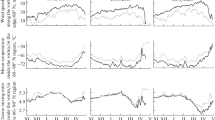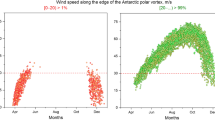Abstract
Ozone evolution and diabatic descent in the Arctic polar vortex in winter 1995/1996 was studied with a newly developed diabatic trajectory–chemistry model (DTCM). To study the chemical and dynamic evolution of the species in the polar vortex, 400 diabatic trajectories were calculated in the vortex core and edge region by using three-dimensional (3-D) wind data provided by the European Centre for Medium-Range Weather Forecasts (ECMWF). The averaged diabatic descending motion and ozone behavior were obtained for particles started from the core and from the edge region of the vortex. The difference in ozone-loss rates as well as the difference in descending rates between the vortex core and the vortex-edge region was not statistically significant. The average cumulative ozone loss of 65 ± 16% in the vortex core obtained from the model calculations was consistent with the estimates obtained with a different method (Match experiment). The model results for the vortex core were compared with those obtained using trajectories with the vertical winds calculated on the basis of radiative cooling rates as used by the SLIMCAT 3-D chemical transport model. Although the trajectories based on cooling rates exhibited lower descending rates than those based on 3-D analyzed wind data, the ozone behavior was similar for both types of trajectory. Ozonesonde data from two stations (Ny-Alesund in the vortex core and Yakutsk in the vortex edge) were compared with the model results. For Lagrangian estimation of the ozone loss at these stations, the descending rates obtained by the diabatic trajectory calculations were used. Good agreements were obtained between the model results and observations for both the vortex core and edge region. These results suggest that strong ozone depletion occurred not only in the core, but also in the edge region of the vortex, and that air masses from the mid-latitudes did not appreciably affect the degree of ozone depletion in this winter–spring period. The sensitivity of the model to different descending rates and to the presence of large nitric acid trihydrate (NAT) particles was also examined.
Similar content being viewed by others
References
Becker, G., Muller, R., McKenna, D. S., Rex, M., Carslaw, K. S., and Oelhaf, H., 2000: Ozone loss rates in the Arctic stratosphere in the winter 1994/1995: Model simulations underestimate results of the Match analysis, J. Geophys. Res. 105, 15175-15184.
Bregman A., van den Broek, M., Carslaw, K. S., Muller, R., Peter, T., Scheele, M. P., and Lelieveld, J., 1997: Ozone depletion in the late winter lower Arctic stratosphere: observations and model results, J. Geophys. Res. 102, 10815-10828.
Brown, S. S., Talukdar, R. K., and Ravishankara, A. R., 1999a: Reconsideration of the rate constants for the reaction of hydroxyl radicals with nitric acid vapor, J. Phys. Chem. 103, 3031-3037.
Brown, S. S., Talukdar, R. K., and Ravishankara, A. R., 1999b: Rate constant for the Reaction OH + ??NO2 ??M ? ?HNO3 ??Munder atmospheric conditions, Chem. Phys. Lett. 299, 277-284.
Carslaw, K., Luo, B., and Peter, T., 1995: An analytic expression for the composition of aqueous HNO3 -? H2SO4 stratospheric aerosols including gas phase removal of HNO3, Geophys. Res. Lett. 22, 1877-1880.
Chipperfield, M. P., 1999: Multiannual simulations with a three-dimensional chemical transport model, J. Geophys. Res. 104, 1781-1805.
DeMore W. B., Sander, S. P., Golden, D. M., Hampson, R. F., Kurylo, M. J., Howard, C. J., Ravishankara, A. R., Kolb, C. E., and Molina, M. J., 1997: Chemical kinetics and photochemical data for use in stratospheric modeling, Evaluation 12, NASA JPL Publ., 97–4.
Deniel C. and Bevilacqua, R. M., 1998: Arctic chemical ozone depletion during the 1994-1995 winter deduced from POAM II satellite observations and the REPROBUS three-dimensional model, J. Geophys. Res. 103, 19,231-19,244.
Dhaniyala S., McKinney, K. A., and Wennberg, P. O., 2002: Lee-wave clouds and denitrification of the polar stratosphere, Geophys. Res. Lett., submitted.
Fahey, D. W., Gao, R. S., Carslaw, K. S., Kettleborough, J., Popp, P. J., Northway, M. J., Holecek, J. C., Ciciora, S. C., McLaughlin, R. J., Thompson, T. L., Winkler, R. H., Baumgardner, D. G., Gandrud, B., Wennberg, P. O., Dhaniyala, S., McKinney, K., Peter, T., Salawitch, R. J., Bui, T. P., Elkins, J. W., Webster, C. R., Atlas, E. L., Jost, H., Wilson, J. C., Herman, R. L., Kleinbohl, A., and von Konig, M., 2001: The detection of large HNO3-containing particles in the winter Arctic stratosphere, Science 291, 1026-1031.
Fueglistaler S., Luo, B. P., Voigt, C., Carslaw, K. S., and Peter, T., 2002: NAT-rock formation by mother clouds: A microphysical model study, Atmos. Chem. Phys. Discuss. 2, 29-42.
Gierczak, T., Burkholder, J. B., and Ravishankara, A. R., 1999: Temperature dependent rate coefficient for the reaction: O(3P)+ NO2 →NO + O2, J. Phys. Chem. 103, 877-883.
Guirlet, M., Chipperfield, M. P., Pyle, J. A., Goutail, F., Pommereau, J. P., and Kyro, E., 2000: Modeled Arctic ozone depletion in winter 1997/1998 and comparison with previous winters, J. Geophys. Res. 105, 22185-22200.
Hanson, D. R. and Mauersberger, K., 1988: Vapour-pressures of HNO3H2O solutions at low temperatures, J. Phys. Chem. 92, 6167-6170.
Hertel, O., Berkowicz, R., Christensen, J., and Hov, O., 1993: Test of two numerical schemes for use in atmospheric transport-chemistry models, Atmos. Environ. 27A(16), 2591-2611.
Hicke, J. and Tuck, A., 1999: Tropospheric clouds and lower stratospheric heating rates: Results from late winter in the southern hemisphere. J. Geophys. Res. 104, 9309-9324.
Hicke, J. and Tuck, A., 2001: Polar stratospheric cloud impacts on Antarctic stratospheric heating rates, Quart. J. Roy. Meteorol. Soc. 127, 1645-1658.
Kilbane-Dawe I., Harris, N. R. P., Pyle, J. A., Rex, M., Lee, A. M., and Chipperfield, M. P., 2001: A comparison of Match ozonesonde-derived and 3D model ozone loss rates in the Arctic polar vortex during the winters of 1994/95 and 1995/96, J. Atmos. Chem. 39, 123-138.
Knudsen, B. M., Larsen, N., Mikkelsen, I. S., Morcrette, J. J., Braathen, G. O., Kyro, E., Fast, H., Gernandt, H., Kanzawa, H., Nakane, H., Dorokhov, V., Yushkov, V., Hansen, G., Gil, M., and Shearman, R. J., 1998: Ozone depletion in and below the Arctic vortex for 1997, Geophys. Res. Lett. 25, 627-630.
Lee, A. M., Roscoe, H. K., Jones, A. E., Haynes, P. H., Shuckburgh, E. F., Morrey, M. W., and Pumphrey, H. C., 2001: The impact of the mixing properties within the Antarctic stratospheric vortex on ozone loss in spring, J. Geophys. Res. 106, 3203-3211.
Lefevre, F., Brasseur, G. P., Folkins, I., Smith, A. K., and Simon, P., 1994: Chemistry of the 1991-1992 stratospheric winter: Three-dimensional model simulations, J. Geophys. Res. 99, 8183-8195.
Lefevre, F., Figarol, F., Carslaw, K. S., and Peter, T., 1998: The 1997 Arctic ozone depletion quantified from three-dimensional model simulations, Geophys. Res. Lett. 25, 2425-2428.
Lucic, D., Harris, N. R., Pyle, J. A., and Jones, R. L., 1999: A technique for estimating polar ozone loss: Results for the northern 1991/92 winter using EASOE data, J. Atmos. Chem. 34, 365-383.
Murray, F. W., 1967: On the computation of saturation vapour pressure, J. Appl. Meteorol. 6, 203-204.
Nash, E. R., Newman, P. A., Rosenfield, J. E., and Schoeberl, M. R., 1996: An objective determination of the polar vortex using Ertel’s potential vorticity, J. Geophys. Res. 101, 9471-9478.
Rex, M., Harris, N. R., von der Gathen, P., Lehmann, R., Braathen, G. O., Reimer, E., Beck, A., Chipperfield, M., Alfier, R., Allaart, M., O'Connor, F., Dier, H., Dorokhov, V., Fast, H., Gil, M., Kyro, E., Litynska, Z., Mikkelsen, I. S., Molyneux, M., Nakane, H., Notholt, J., Rummukainen, M., Viatte, P., and Wenger, J., 1997: Prolonged stratospheric ozone loss in the 1995-96 Arctic winter, Nature 389, 835-838.
Schoeberl, M. R., Lait, L. R., Newman, P. A., and Rosenfield, J. E., 1992: The structure of the polar vortex, J. Geophys. Res. 97, 7859-7882.
Schulz, A., Rex, M., Steger, J., Harris, N. R., Braathen, G. O., Reimer, E., Alfier, R., Beck, A., Alpers, M., Cisneros, J., Claude, H., Backer, H. D., Dier, H., Dorokhov, V., Fast, H., Godin, S., Hansen, G., Kanzawa, H., Kois, B., Kondo, Y., Kosmidis, E., Kyro, E., Litynska, Z., Molyneux, M., Murphy, G., Nakane, H., Parrondo, C., Ravegnani, F., Varotsos, C., Vialle, C., Viatte, P., Yushkov, V., Zerefos, C., and von der Gathen, P., 2000: Match observations in the Arctic winter 1996/97: High stratospheric ozone loss rates correlate with low temperatures deep inside the polar vortex, Geophys. Res. Lett. 27, 205-208.
Sutton, R. T., MacLean, H., Swinbank, R., O’Neill, A., and Taylor, F. W., 1994: High-resolution stratospheric tracer fields estimated from satellite observations using Lagrangian trajectory calculations, J. Atmos. Sci. 51, 2995-3005.
Tabazadeh, A., Santee, M. L., Danilin, M. Y., Pumphrey, H. C., Newman, P. A., Hamill, P. J., and Mergenthaler, J. L., 2000: Quantifying denitrification and its effect on ozone recovery, Science 288, 1407-1411.
Verwer, J. G., Blom, J. G., Van Loon, M., and Spee, E. J., 1996: A comparison of stiff ODE solvers for atmospheric chemistry problems, Atmos. Environ. 1, 49-58.
Waibel, A. E., Peter, T., Carslaw, K. S., Oelhaf, H., Wetzel, G., Crutzen, P. J., Poschl, U., Tsias, A., Reimer, E., and Fisher, H., 1999: Arctic ozone loss due to denitrification, Science 283, 2064-2069.
Author information
Authors and Affiliations
Corresponding author
Rights and permissions
About this article
Cite this article
Lukyanov, A.N., Nakane, H. & Yushkov, V.A. Lagrangian Estimations of Ozone Loss in the Core and Edge Region of the Arctic Polar Vortex 1995/1996: Model Results and Observations. Journal of Atmospheric Chemistry 44, 191–210 (2003). https://doi.org/10.1023/A:1022497308731
Issue Date:
DOI: https://doi.org/10.1023/A:1022497308731




